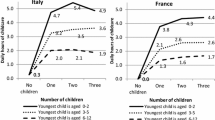Abstract
A regression model which combines both the time cost and relative income hypotheses is estimated using Canadian data. The results indicate that the influence of relative income is greater on completed fertility and the effect of time cost is greater on timing of births. Some policy implications are derived.
Similar content being viewed by others
References
Abeysinghe T (1990) Economic theories of fertility: A reappraisal. In: Quah E, Chin A (eds) Surveys in modern economics. McGraw-Hill, Singapore, pp 46–67
Abeysinghe T (1991) On testing Easterlin's hypothesis using relative cohort size as a proxy for relative income: An analysis of Canadian date. J Popul Econ 4:53–69
Becker GS (1960) An economic analysis of fertility. In: Demographic and economic change in developed countries. Universities National Bureau Conference Series No 11. Princeton University Press, Princeton, pp 209–231
Butz WP, Ward MP (1979) The emergence of countercyclical U.S. fertility. Am Econ Rev 69:318–328
Cigno A, Ermisch J (1989) A microeconomic analysis of the timing of births. Eur Econ Rev 33:737–760
Easterlin RA (1973) Relative economic status and the American fertility swing. In: Sheldon EB (ed) Family economic behavior: Problems and prospects. J. B. Lippincott, Philadelphia, pp 170–233
Easterlin RA (1980) American population since 1940. In: Feldstein M (ed) The American economy in transition. Chicago University Press, Chicago, pp 275–347
Easterlin RA, Pollak RA, Wachter ML (1980) Toward a more general economic model of fertility determination: endogenous preferences and natural fertility. In: Easterlin RA (ed) Population and economic change in developed countries. NBER, Chicago University Press, Chicago, pp 81–150
Engle RF, Granger CWJ (1987) Co-integration, and error correction: representation, estimation and testing. Econometrica 55:251–276
Engle RF, Yoo BS (1987) Forecasting and testing in cointegrated systems. J Economet 35:143–159
Ermisch J (1988) Econometric analysis of birth rate dynamics in Britain. J Human Resources 23:563–576
Hansen BE (1992) Test for parameter instability in regressions with I(1) processes. J Business Econ Stat (forthcoming) Hansen BE, Phillips PCB (1990) Estimation and inference in models of cointegration: A simulation study. In: Fomby TB, Rhodes GF Jr (eds) Advances in econometrics. Res Annu 8:225–248
Hyatt DE, Milne WJ (1991) Countercyclical fertility in Canada: Some empirical results. Can Studies Popul 18:1–16
Johansen S, Juselius K (1990) Maximum likelihood estimation and inference on cointegration — with applications to the demand for money. Oxford Bull Econ Stat 52:169–210
Moffitt RA (1982) Postwar fertility cycles and the Easterlin hypothesis: Life-cycle approach. Res Popul Econ 4:237–252
Rutten A, Higgs R (1984) Graphic tests of Easterlin's hypothesis: Science or art? Res Popul Econ 5:201–212
Schultz TW (ed) (1974) Economics of the family. NBER, Chicago University Press, Chicago
Wachter ML (1975) A time series fertility equation: The potential for a baby boom in the 1980's. Int Econ Rev 16:609–624
Willis RJ (1987) What have we learned from the economics of the family? Am Econ Rev 77:68–82
Author information
Authors and Affiliations
Additional information
I would like to thank Michael Rohatynsky for helping me in collecting data, John Ermisch and three anonymous referees for their insightful and constructive comments.
Rights and permissions
About this article
Cite this article
Abeysinghe, T. Time cost, relative income and fertility in Canada. J Popul Econ 6, 189–198 (1993). https://doi.org/10.1007/BF00178562
Received:
Accepted:
Issue Date:
DOI: https://doi.org/10.1007/BF00178562




